Abstract
Purified peptidoglycan (PG) obtained from Neisseria gonorrhoeae was tested for the ability to consume complement in normal human sera. Sonicated PG (S-PG), a heterogeneous mixture of soluble fragments (molecular weight, greater than 10(6)), as well as intact (insoluble) PG, reduced the level of whole hemolytic complement in a pool of four human sera. The minimal concentration of S-PG required for this activity was approximately 500 micrograms of S-PG per ml of serum. Complete lysozyme digestion of S-PG, yielding PG fragments of less than 10(4) molecular weight, eliminated complement-consuming activity. S-PG-mediated complement consumption resulted in depletion of the individual complement components C4 and C3. Consumption of complement did not occur when C4-deficient human serum or normal human sera treated with Mg2+-(ethylene glycol-bis(beta-aminoethyl ether)-N,N-tetraacetic acid to specifically impair classical complement pathway activity were used. The addition of rabbit anti-PG antibody greatly enhanced gonococcal PG-mediated complement consumption. Together, the data suggested that gonococcal PG-mediated complement consumption occurred via the classical complement pathway, was dependent on the presence of anti-PG antibody, and required glycosidically linked polymers of PG. Individual human sera varied widely in the extent of gonococcal PG-mediated reduction of complement levels, presumably a reflection of either different amounts of natural antibody to gonococcal PG, different levels of human PG hydrolase(s) capable of degrading PG to inactive fragments, or both.
Full text
PDF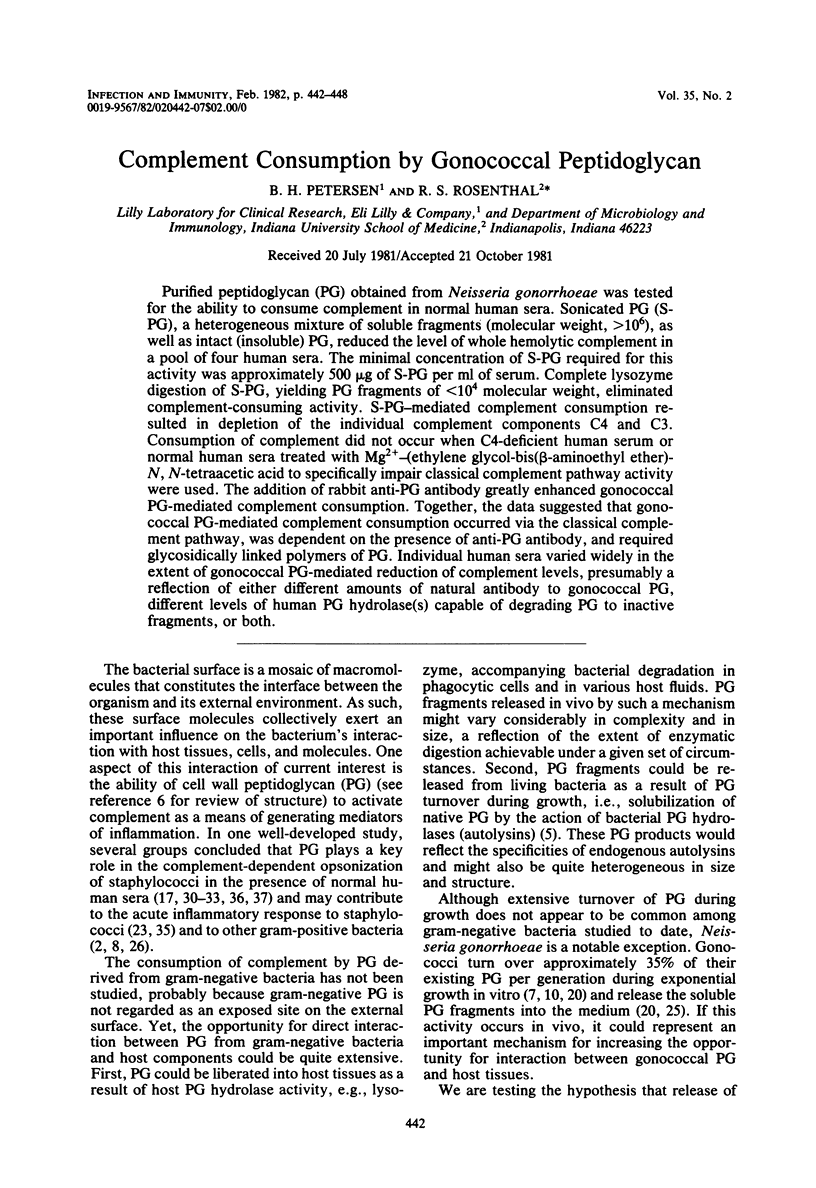
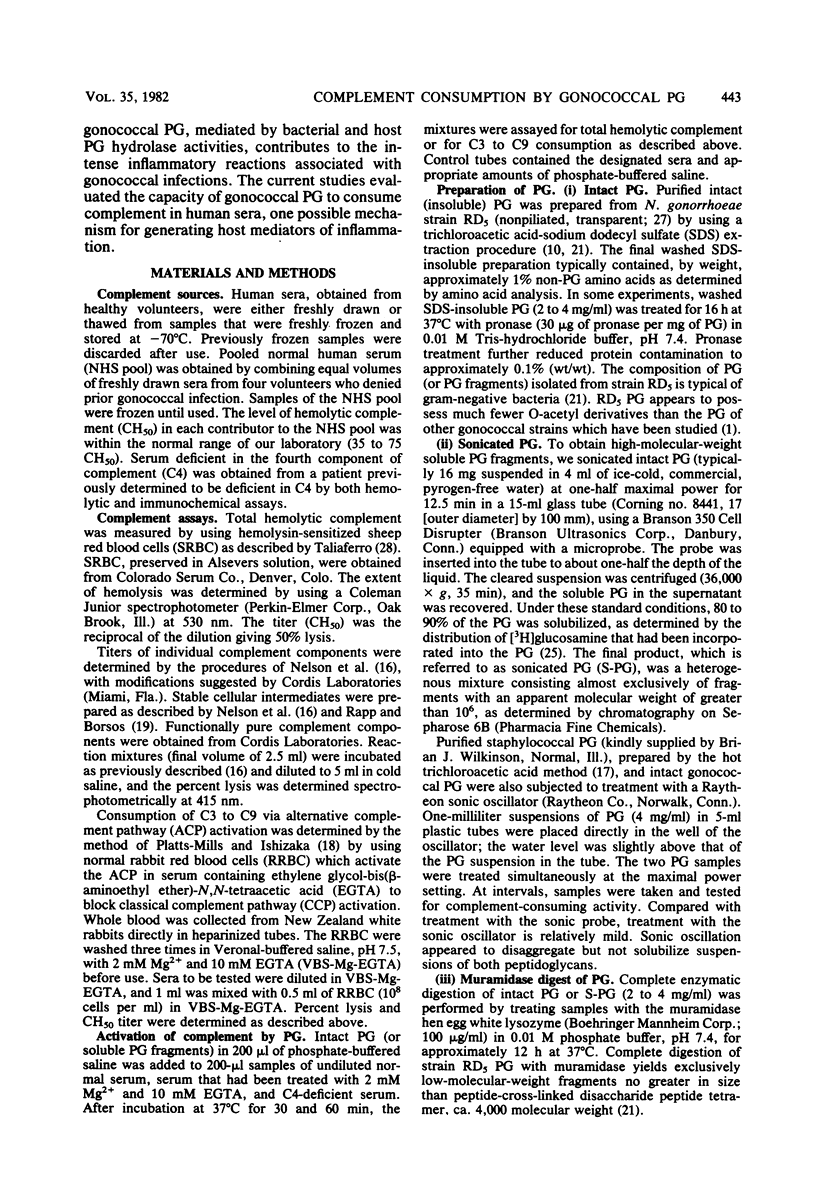
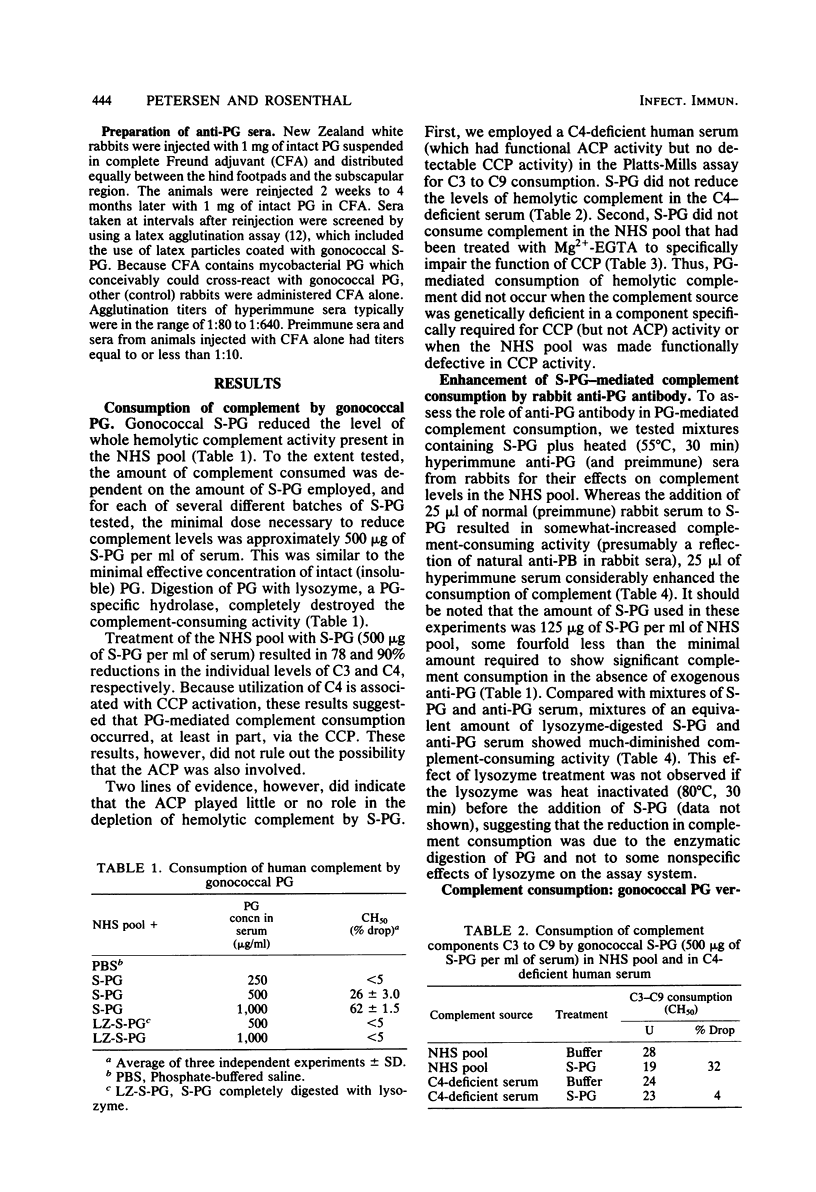
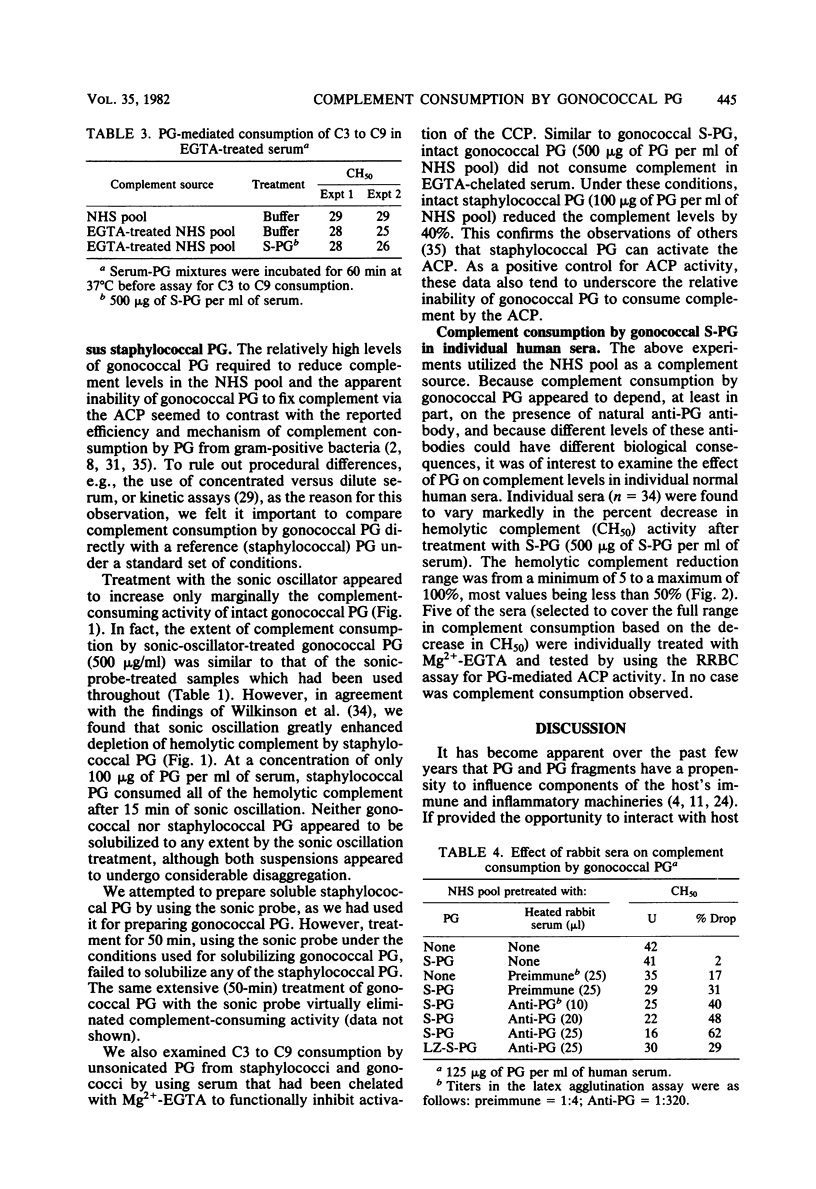
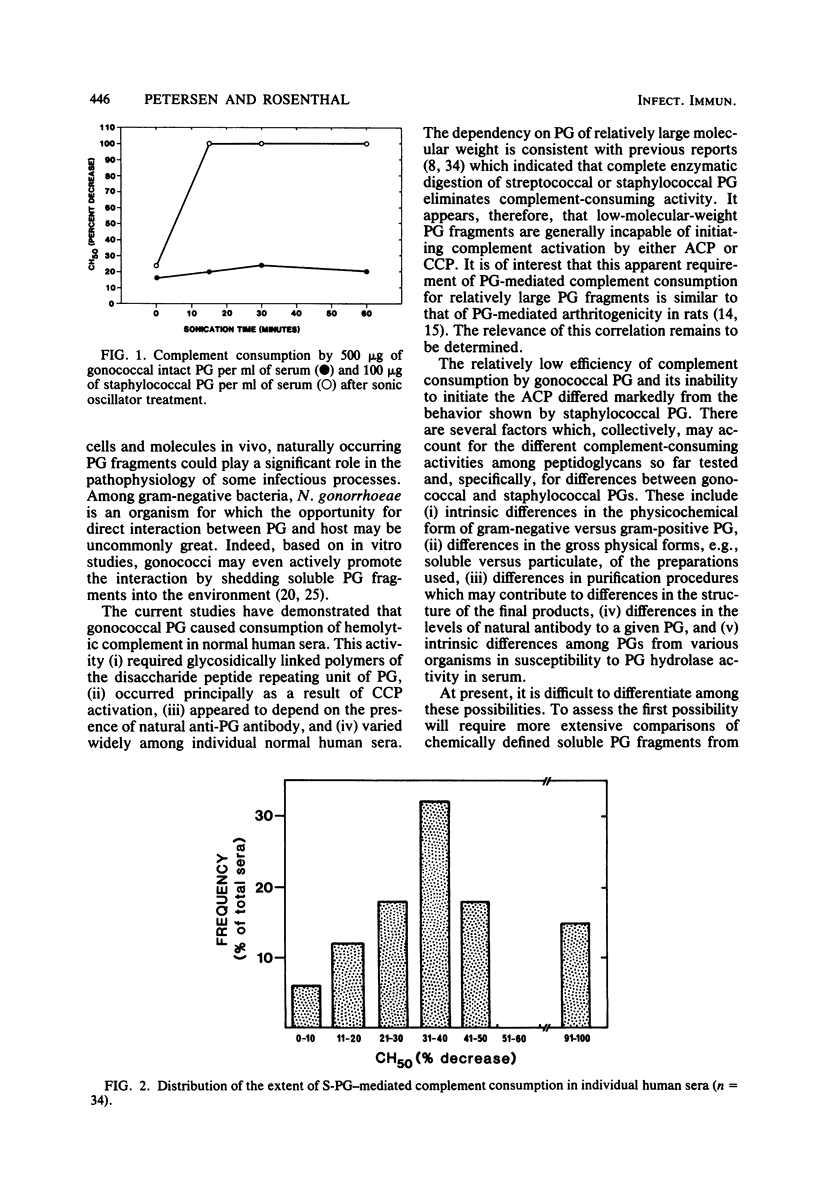
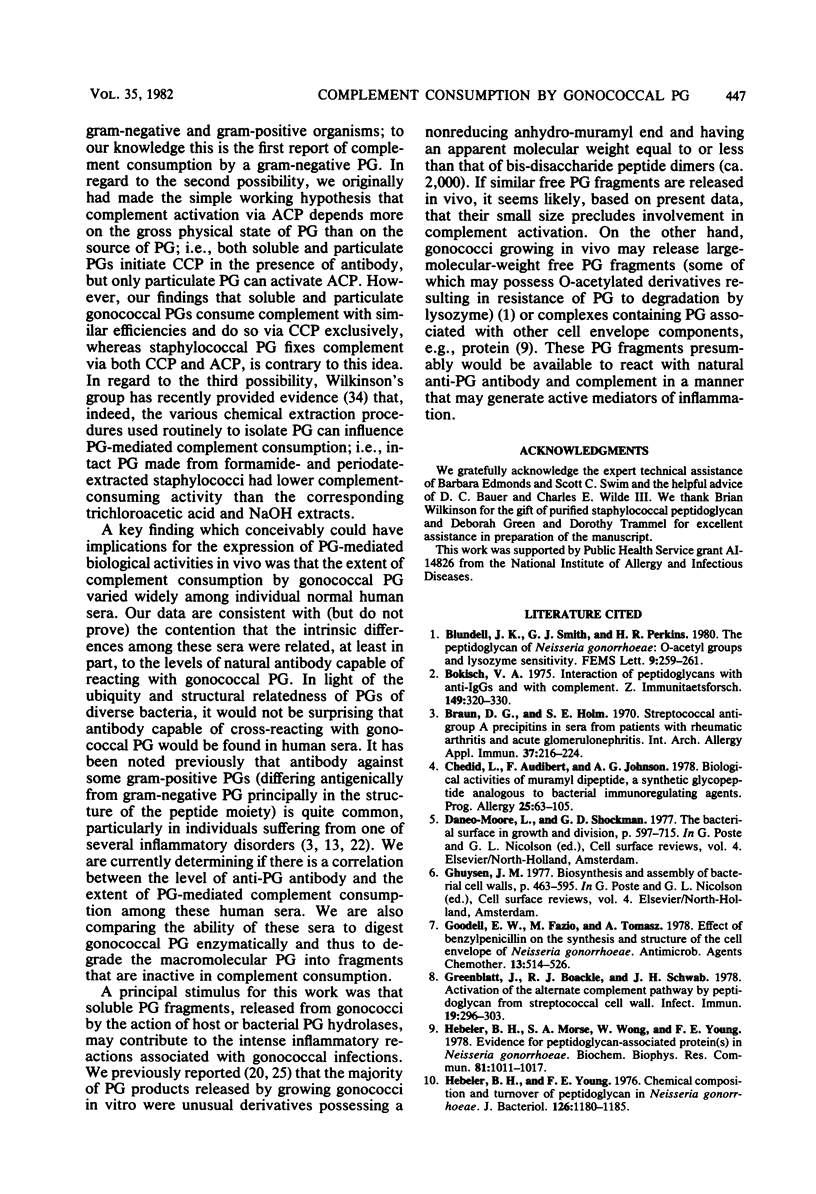
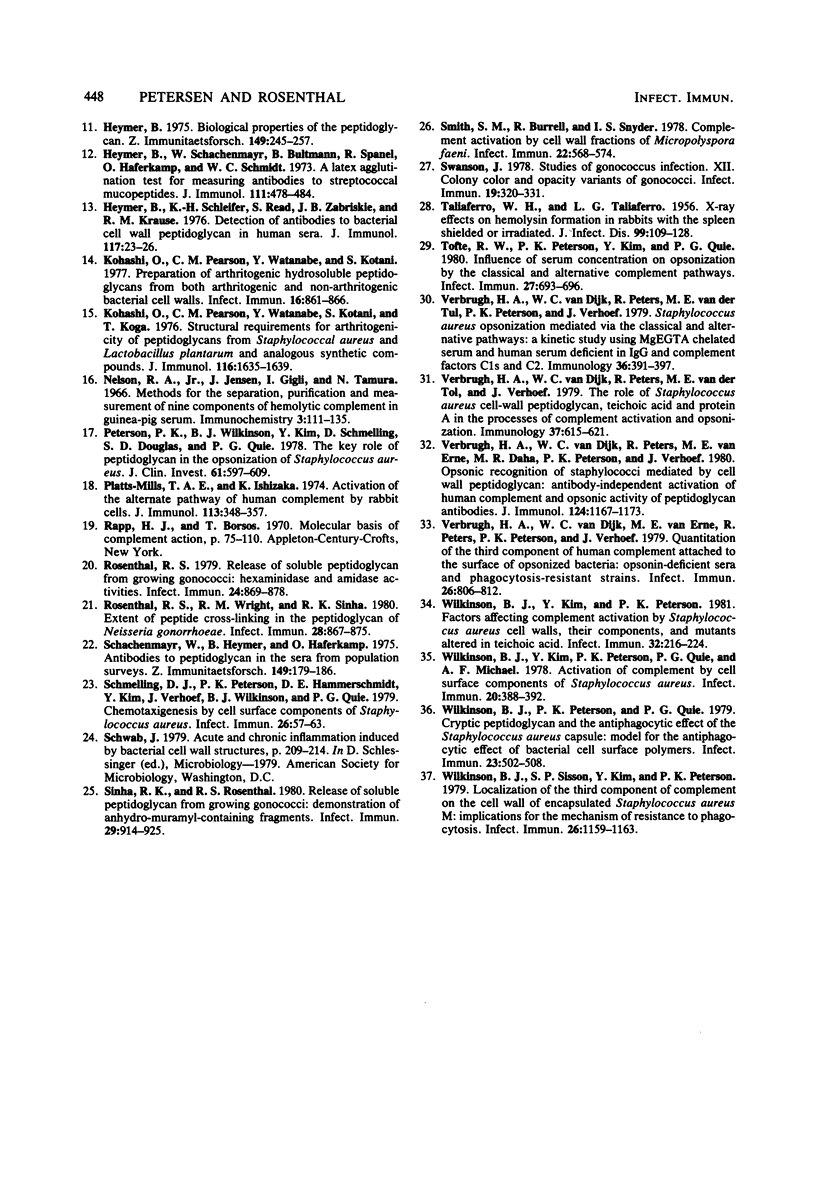
Selected References
These references are in PubMed. This may not be the complete list of references from this article.
- Braun D. G., Holm S. E. Streptococcal anti-group A precipitins in sera from patients with rheumatic arthritis and acute glomerulonephritis. Int Arch Allergy Appl Immunol. 1970;37(2):216–224. doi: 10.1159/000230234. [DOI] [PubMed] [Google Scholar]
- Chedid L., Audibert F., Johnson A. G. Biological activities of muramyl dipeptide, a synthetic glycopeptide analogous to bacterial immunoregulating agents. Prog Allergy. 1978;25:63–105. [PubMed] [Google Scholar]
- Goodell E. W., Fazio M., Tomasz A. Effect of benzylpenicillin on the synthesis and structure of the cell envelope of Neisseria gonorrhoeae. Antimicrob Agents Chemother. 1978 Mar;13(3):514–526. doi: 10.1128/aac.13.3.514. [DOI] [PMC free article] [PubMed] [Google Scholar]
- Greenblatt J., Boackle R. J., Schwab J. H. Activation of the alternate complement pathway by peptidoglycan from streptococcal cell wall. Infect Immun. 1978 Jan;19(1):296–303. doi: 10.1128/iai.19.1.296-303.1978. [DOI] [PMC free article] [PubMed] [Google Scholar]
- Hebeler B. H., Morse S. A., Wong W., Young F. E. Evidence for peptidoglycan-associated protein(s) in Neisseria gonorrhoeae. Biochem Biophys Res Commun. 1978 Apr 14;81(3):1011–1017. doi: 10.1016/0006-291x(78)91451-1. [DOI] [PubMed] [Google Scholar]
- Hebeler B. H., Young F. E. Chemical composition and turnover of peptidoglycan in Neisseria gonorrhoeae. J Bacteriol. 1976 Jun;126(3):1180–1185. doi: 10.1128/jb.126.3.1180-1185.1976. [DOI] [PMC free article] [PubMed] [Google Scholar]
- Heymer B. Biological properties of the peptidoglycan. Z Immunitatsforsch Exp Klin Immunol. 1975 Jul;149(2-4):245–257. [PubMed] [Google Scholar]
- Heymer B., Schachenmayr W., Bültmann B., Spanel R., Hafferkamp O., Schmidt W. C. A latex agglutination test for measuring antibodies to Streptococcal mucopeptides. J Immunol. 1973 Aug;111(2):478–484. [PubMed] [Google Scholar]
- Heymer B., Schleifer K. H., Read S., Zabriskie J. B., Krause R. M. Detection of antibodies to bacterial cell wall peptidoglycan in human sera. J Immunol. 1976 Jul;117(1):23–26. [PubMed] [Google Scholar]
- Kohashi O., Pearson C. M., Watanabe Y., Kotani S., Koga T. Structural requirements for arthritogenicity of peptidoglycans from Staphylococcus aureus and Lactobacillus plant arum and analogous synthetic compounds. J Immunol. 1976 Jun;116(6):1635–1639. [PubMed] [Google Scholar]
- Kohashi O., Pearson C. M., Watanabe Y., Kotani S. Preparation of arthritogenic hydrosoluble peptidoglycans from both arthritogenic and non-arthritogenic bacterial cell walls. Infect Immun. 1977 Jun;16(3):861–866. doi: 10.1128/iai.16.3.861-866.1977. [DOI] [PMC free article] [PubMed] [Google Scholar]
- Nelson R. A., Jr, Jensen J., Gigli I., Tamura N. Methods for the separation, purification and measurement of nine components of hemolytic complement in guinea-pig serum. Immunochemistry. 1966 Mar;3(2):111–135. doi: 10.1016/0019-2791(66)90292-8. [DOI] [PubMed] [Google Scholar]
- Peterson P. K., Wilkinson B. J., Kim Y., Schmeling D., Douglas S. D., Quie P. G., Verhoef J. The key role of peptidoglycan in the opsonization of Staphylococcus aureus. J Clin Invest. 1978 Mar;61(3):597–609. doi: 10.1172/JCI108971. [DOI] [PMC free article] [PubMed] [Google Scholar]
- Platts-Mills T. A., Ishizaka K. Activation of the alternate pathway of human complements by rabbit cells. J Immunol. 1974 Jul;113(1):348–358. [PubMed] [Google Scholar]
- Rosenthal R. S. Release of soluble peptidoglycan from growing gonococci: hexaminidase and amidase activities. Infect Immun. 1979 Jun;24(3):869–878. doi: 10.1128/iai.24.3.869-878.1979. [DOI] [PMC free article] [PubMed] [Google Scholar]
- Rosenthal R. S., Wright R. M., Sinha R. K. Extent of peptide cross-linking in the peptidoglycan of Neisseria gonorrhoeae. Infect Immun. 1980 Jun;28(3):867–875. doi: 10.1128/iai.28.3.867-875.1980. [DOI] [PMC free article] [PubMed] [Google Scholar]
- Schachenmayr W., Heymer B., Haferkamp O. Antibodies to peptidoglycan in the sera from population surveys. Z Immunitatsforsch Exp Klin Immunol. 1975 Jul;149(2-4):179–186. [PubMed] [Google Scholar]
- Schmeling D. J., Peterson P. K., Hammerschmidt D. E., Kim Y., Verhoef J., Wilkinson B. J., Quie P. G. Chemotaxigenesis by cell surface components of Staphylococcus aureus. Infect Immun. 1979 Oct;26(1):57–63. doi: 10.1128/iai.26.1.57-63.1979. [DOI] [PMC free article] [PubMed] [Google Scholar]
- Sinha R. K., Rosenthal R. S. Release of soluble peptidoglycan from growing conococci: demonstration of anhydro-muramyl-containing fragments. Infect Immun. 1980 Sep;29(3):914–925. doi: 10.1128/iai.29.3.914-925.1980. [DOI] [PMC free article] [PubMed] [Google Scholar]
- Smith S. M., Burrell R., Snyder I. S. Complement activation by cell wall fractions of Micropolyspora faeni. Infect Immun. 1978 Nov;22(2):568–574. doi: 10.1128/iai.22.2.568-574.1978. [DOI] [PMC free article] [PubMed] [Google Scholar]
- Swanson J. Studies on gonococcus infection. XII. Colony color and opacity varienats of gonococci. Infect Immun. 1978 Jan;19(1):320–331. doi: 10.1128/iai.19.1.320-331.1978. [DOI] [PMC free article] [PubMed] [Google Scholar]
- TALIAFERRO L. G., TALIAFERRO W. H. X-ray effects on hemolysin formation in rabbits with the spleen shielded or irradiated. J Infect Dis. 1956 Sep-Oct;99(2):109–128. doi: 10.1093/infdis/99.2.109. [DOI] [PubMed] [Google Scholar]
- Tofte R. W., Peterson P. K., Kim Y., Quie P. G. Influence of serum concentration on opsonization by the classical and alternative complement pathways. Infect Immun. 1980 Feb;27(2):693–696. doi: 10.1128/iai.27.2.693-696.1980. [DOI] [PMC free article] [PubMed] [Google Scholar]
- Verbrugh H. A., Van Dijk W. C., Peters R., Van Der Tol M. E., Peterson P. K., Verhoef J. Staphylococcus aureus opsonization mediated via the classical and alternative complement pathways. A kinetic study using MgEGTA chelated serum and human sera deficient in IgG and complement factors C1s and C2. Immunology. 1979 Mar;36(3):391–397. [PMC free article] [PubMed] [Google Scholar]
- Verbrugh H. A., Van Dijk W. C., Peters R., Van Der Tol M. E., Verhoef J. The role of Staphylococcus aureus cell-wall peptidoglycan, teichoic acid and protein A in the processes of complement activation and opsonization. Immunology. 1979 Jul;37(3):615–621. [PMC free article] [PubMed] [Google Scholar]
- Verbrugh H. A., van Dijk W. C., Peters R., van Erne M. E., Daha M. R., Peterson P. K., Verhoef J. Opsonic recognition of staphylococci mediated by cell wall peptidoglycan: antibody-independent activation of human complement and opsonic activity of peptidoglycan antibodies. J Immunol. 1980 Mar;124(3):1167–1173. [PubMed] [Google Scholar]
- Wilkinson B. J., Kim Y., Peterson P. K. Factors affecting complement activation by Staphylococcus aureus cell walls, their components, and mutants altered in teichoic acid. Infect Immun. 1981 Apr;32(1):216–224. doi: 10.1128/iai.32.1.216-224.1981. [DOI] [PMC free article] [PubMed] [Google Scholar]
- Wilkinson B. J., Kim Y., Peterson P. K., Quie P. G., Michael A. F. Activation of complement by cell surface components of Staphylococcus aureus. Infect Immun. 1978 May;20(2):388–392. doi: 10.1128/iai.20.2.388-392.1978. [DOI] [PMC free article] [PubMed] [Google Scholar]
- Wilkinson B. J., Peterson P. K., Quie P. G. Cryptic peptidoglycan and the antiphagocytic effect of the Staphylococcus aureus capsule: model for the antiphagocytic effect of bacterial cell surface polymers. Infect Immun. 1979 Feb;23(2):502–508. doi: 10.1128/iai.23.2.502-508.1979. [DOI] [PMC free article] [PubMed] [Google Scholar]
- Wilkinson B. J., Sisson S. P., Kim Y., Peterson P. K. Localization of the third component of complement on the cell wall of encapsulated Staphylococcus aureus M: implications for the mechanism of resistance to phagocytosis. Infect Immun. 1979 Dec;26(3):1159–1163. doi: 10.1128/iai.26.3.1159-1163.1979. [DOI] [PMC free article] [PubMed] [Google Scholar]


